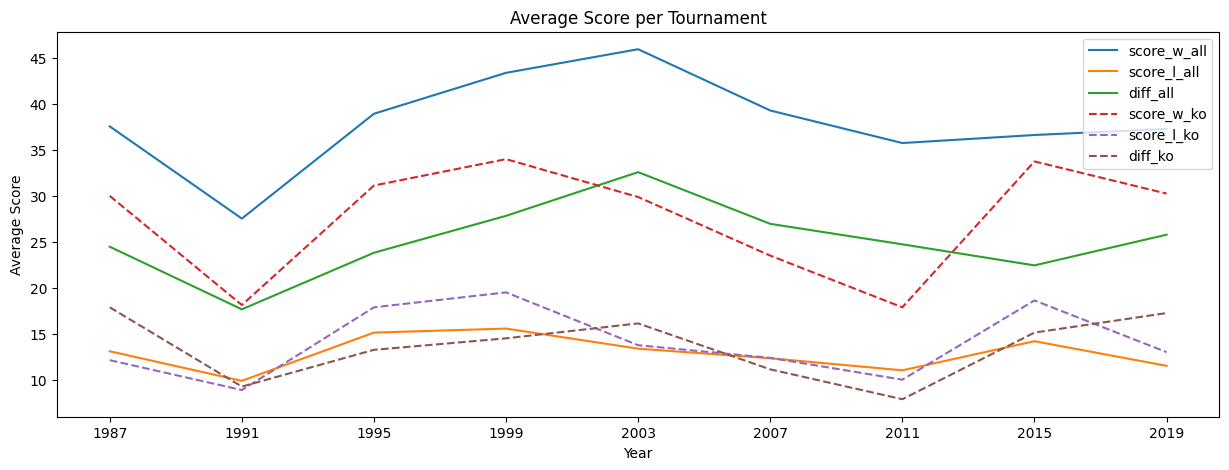What is the average Rugby World Cup score?
Over the weekend, I started writing a rugby guide for newbies. In it I wanted to include some information about the average score of a RWC match. I thought it would be interesting to see how the average score has changed over time, and the difference between pool matches and knockout matches.
Thankfully, this requires a reasonable small dataset that is already available having worked on Rugby Bot for the past few years. This includes all Men’s matches from the World Cup until the 2019 edition.
print(df.shape)
>>> (377, 18)
and in true data science fashion, the data is the most important part. We need to remove the matches that were cancelled in the 2019 World Cup, otherwise these “0-0” matches will distort our averages.
df = df[~df.cancelled]
df.shape
>>> (374, 18)
df.columns
>>> Index(['id', 'c_home', 'c_away', 'dt', 'dt_utc', 'score_h', 'score_a',
'venue_id', 'home_name', 'away_name', 'venue', 'm_pool', 'qf', 'sf',
'bronze', 'final', 'knockout', 'cancelled'],
dtype='object')
“Home” and “Away” don’t really apply in a World Cup context, so we can use more appropriate fields:
df["winner"] = df.apply(lambda x: x["c_home"] if x["score_h"] > x["score_a"] else x["c_away"], axis=1)
df["loser"] = df.apply(lambda x: x["c_home"] if x["score_h"] < x["score_a"] else x["c_away"], axis=1)
df["score_w"] = df.apply(lambda x: x["score_h"] if x["score_h"] > x["score_a"] else x["score_a"], axis=1)
df["score_l"] = df.apply(lambda x: x["score_a"] if x["score_h"] > x["score_a"] else x["score_h"], axis=1)
Now that we are set up, we can run some quick calculations:
df.score_w.mean(), df.score_l.mean(), (df.score_w - df.score_l).mean()
>>> (38.37433155080214, 12.885026737967914, 25.489304812834224)
Average Result
Overall, the average result in Rugby World Cup matches is 38 - 13. At first pass, these numbers seem higher than the usual matches in the Six Nations or Rugby Championship. This would be due to the fact that there is a bigger difference in rankings in the World Cup, and more one-sided matches.
Pools vs Knockouts
Let’s split it by pool and knockout matches:
df_pool = df[~df.knockout]
df_knockout = df[df.knockout]
df_pool.score_w.mean(), df_pool.score_l.mean(), (df_pool.score_w - df_pool.score_l).mean()
>>> (40.94039735099338, 12.6158940397351, 28.32450331125828)
df[df.knockout].score_w.mean(), df[df.knockout].score_l.mean(), (df[df.knockout].score_w - df[df.knockout].score_l).mean()
>>> (27.61111111111111, 14.01388888888889, 13.597222222222221)
So the pool matches are much more one sided than the knockout matches, as expected.
We can further break this down by stage of knockout match:
# Different knockout stages
stages = ["qf", "sf", "bronze", "final"]
stagedata = []
for stage in stages:
df_stage = df[df[stage]]
stagedata.append((stage, df_stage.score_w.mean(), df_stage.score_l.mean(), (df_stage.score_w - df_stage.score_l).mean()))
pd.DataFrame(stagedata, columns=["stage", "score_w", "score_l", "diff"])
| stage | score_w | score_l | diff | |
|---|---|---|---|---|
| 0 | qf | 30.611111 | 14.972222 | 15.638889 |
| 1 | sf | 25.055556 | 13.722222 | 11.333333 |
| 2 | bronze | 26.111111 | 13.888889 | 12.222222 |
| 3 | final | 22.222222 | 10.888889 | 11.333333 |
The scores get closer as we go further in the tournament. However, the bronze match and Final only have a sample size of 9 which is not a significant amount. But it does support our general intuition.
Across Tournaments
We can also have a look at how the scoring changes across tournaments:
# Across Tournaments
per_tournament = df.groupby(df.dt.str[0:4]).agg({"score_w": "mean", "score_l": "mean"})
per_tournament["diff"] = per_tournament.score_w - per_tournament.score_l
| dt | score_w | score_l | diff |
|---|---|---|---|
| 1987 | 37.5625 | 13.0938 | 24.4688 |
| 1991 | 27.5312 | 9.875 | 17.6562 |
| 1995 | 38.9375 | 15.125 | 23.8125 |
| 1999 | 43.3902 | 15.561 | 27.8293 |
| 2003 | 45.9583 | 13.375 | 32.5833 |
| 2007 | 39.2917 | 12.3333 | 26.9583 |
| 2011 | 35.75 | 11.0208 | 24.7292 |
| 2015 | 36.625 | 14.1875 | 22.4375 |
| 2019 | 37.2889 | 11.5111 | 25.7778 |
For knockouts only:
per_tournament_ko = df_knockout.groupby(df_knockout.dt.str[0:4]).agg({"score_w": "mean", "score_l": "mean"})
per_tournament_ko["diff"] = per_tournament_ko.score_w - per_tournament_ko.score_l
| dt | score_w | score_l | diff |
|---|---|---|---|
| 1987 | 30 | 12.125 | 17.875 |
| 1991 | 18.125 | 8.875 | 9.25 |
| 1995 | 31.125 | 17.875 | 13.25 |
| 1999 | 34 | 19.5 | 14.5 |
| 2003 | 29.875 | 13.75 | 16.125 |
| 2007 | 23.5 | 12.375 | 11.125 |
| 2011 | 17.875 | 10 | 7.875 |
| 2015 | 33.75 | 18.625 | 15.125 |
| 2019 | 30.25 | 13 | 17.25 |
The knockout difference makes sense. Thinking back to the 2007 and 2011 World Cups, the knockout matches were quite … an arm wrestle (snore).
Graph
Since it’s likely easier, we can plot these results for a slightly easier view.

What will the 2023 World Cup look like?